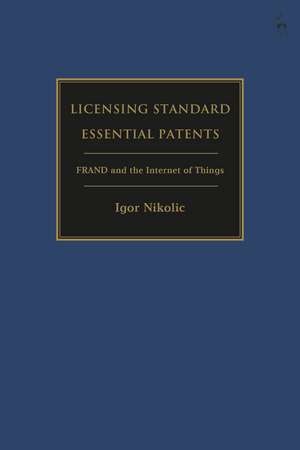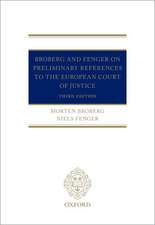Licensing Standard Essential Patents: FRAND and the Internet of Things
Autor Igor Nikolicen Limba Engleză Hardback – 17 noi 2021
Preț: 775.74 lei
Preț vechi: 1052.82 lei
-26% Nou
Puncte Express: 1164
Preț estimativ în valută:
148.44€ • 155.30$ • 123.31£
148.44€ • 155.30$ • 123.31£
Carte tipărită la comandă
Livrare economică 03-17 aprilie
Livrare express 26 februarie-04 martie pentru 165.02 lei
Preluare comenzi: 021 569.72.76
Specificații
ISBN-13: 9781509947553
ISBN-10: 1509947558
Pagini: 320
Dimensiuni: 156 x 234 x 27 mm
Greutate: 0.63 kg
Editura: Bloomsbury Publishing
Colecția Hart Publishing
Locul publicării:London, United Kingdom
ISBN-10: 1509947558
Pagini: 320
Dimensiuni: 156 x 234 x 27 mm
Greutate: 0.63 kg
Editura: Bloomsbury Publishing
Colecția Hart Publishing
Locul publicării:London, United Kingdom
Caracteristici
Provides a one-stop citation source for practitioners and consolidates the arguments, on both sides, in a single, easily referenced location
Notă biografică
Igor Nikolic is Robert Schuman Fellow at the European University Institute, Italy, and Senior Fellow at the Centre for Law, Economics and Society, University College London, UK.
Cuprins
I. Setting the Context II. Structure PART ITHE STANDARD-DEVELOPMENT ENVIRONMENT1. Standards, Standard-Development Organisations and Standard Essential Patents I. Standards A. Technical Interoperability Standards B. Classification of Standards i. Standards Based on their Source a. De Facto Standards b. Collaborative Standards c. Governmental Standards ii. Open and Closed Standards II. Standard Development Organisations A. Types of SDOs B. Membership C. How SDOs Develop Standards III. Standard Essential Patents A. SEPs in IPR Policies of SDOs i. Disclosure Rules ii. Licensing Rules B. The Meaning of Essentiality C. The Problem of Over-Disclosure IV. Conclusion 2. The Dynamics of Standard Essential Patent Licensing: Patent Holdup, Holdout and Royalty Stacking I. Industry Convergences and Changing Market Dynamics II. Patent Holdup and Royalty Stacking A. Patent Holdup B. Royalty Stacking C. The Influence of Patent Holdup and Royalty Stacking Theories III. Criticism of Patent Holdup and Royalty Stacking Theories A. The Lack of Empirical Evidence of Systematic Negative Effects B. The Misunderstanding of the Standardisation Process and Legal Licensing Framework IV. Patent Holdout V. Conclusion PART IITHE MEANING AND CONTENT OF A FRAND LICENCE3. The Nature of a FRAND Commitment I. The Principles and the Text of a FRAND Commitment II. The Enforceability of a FRAND Commitment A. Contract Law i. Can SDO Non-Members Rely on a FRAND Contract? ii. Is a FRAND Commitment Sufficiently Clear to be an Enforceable Contractiii. Transferability of a FRAND Commitment iv. Not All Jurisdictions Recognise Third-Party Beneficiary Rights v. SDOs Could Clarify the Contractual Nature of a FRAND Commitment B. Competition Law i. EU Competition Law and Breach of FRAND Commitments ii. US Antitrust Law and Breach of FRAND Commitments iii. The Role of Competition Law in the SEP Context C. Alternative Theories on the Enforceability of FRAND Commitments III. Conclusion 4. FRAND Royalty I. The Principles of FRAND Royalty A. The Value of the Technology Itself (the Ex Ante Incremental Value Approach) i. Reception in Practice ii. Criticism of the Ex Ante Incremental Value Approach a. Misunderstanding the Standard-Development Process b. Depreciating the Value of SEPs c. Not Used in Real-World Commercial Transactionsd. Inapplicability in Practice B. Sharing the Value of Standardisation II. Calculating FRAND Royalties in Practice A. Comparable Licences i. Application in Practice B. Top-Down Approach i. Application in Practice C. Other Approaches III. Conclusion 5. The Non-Discrimination Requirement of a FRAND Commitment I. Positive and Negative Aspects of Price Discrimination in Standard Essential Patent Licensing II. The Non-Discrimination Requirement in the Text of a FRAND Commitment III. No Requirement to Apply Uniform Terms to All Licensees IV. Interpretations of the Non-Discrimination Requirement of a FRAND Commitment A. Prohibition of Discrimination between Different Levels of the Production Chain B. Prohibiting Price Discrimination of Vertically Integrated SEP Holders against Downstream Competitors C. Prohibiting Discrimination against Similarly Situated Licensees i. Which Licensees are Similarly Situated? ii. When is Dissimilar Treatment Discriminatory? iii. What are the Remedies for Discrimination? V. The Application of the Non-Discrimination Requirement of a FRAND Commitment VI. Confidentiality Agreements and Disclosure of Licences VII. Conclusion 6. FRAND Royalty Base I. Introduction: The End-Product or Component?II. The Appropriate FRAND Royalty Base III. The Legal Requirement to Use a Particular Royalty Base A. Origins and Evolution of the SSPPU Theory i. US Patent Damages System and the Emergence of the SSPPU Theory ii. Reception and Expansion of the SSPPU Doctrine by the Federal Circuit iii. Clarification and Backtracking of the SSPPU Doctrine by the Federal Circuit iv. Jury Bias as a Reason for the Introduction of the SSPPUB. Conclusion IV. The Royalty Base in Standard Essential Patent Litigation V. Conclusion 7. FRAND and Value Chain Licensing I. The Value Chain Licensing Debate II. Patent Law and Value Chain Licensing III. FRAND Commitments and Value Chain Licensing IV. Competition Law and Value Chain Licensing A. Refusal to License and EU Competition Law B. Article 101 TFEU and the Horizontal Cooperation Guidelines C. Refusal to License and US Antitrust Law V. Policy Outlook for the Internet of Things VI. Conclusion 8. Remedies I. Injunctions A. Principles of Equity (US Courts) B. Public Policy (International Trade Commission) C. Unfair Competition (Federal Trade Commission) D. Competition Law (EU) i. The Interpretation of Huawei v ZTE by National CourtsE. Conclusion II. Global or Territorial Scope of a FRAND Licence? III. Antisuit Injunctions IV. Past Damages V. Procedural Remedies to Facilitate Patent Licensing A. A FRAND Trial First B. Interim Payments VI. Conclusion PART IIISTANDARD ESSENTIAL PATENT LICENSING IN THE INTERNET OF THINGS9. Standard Essential Patent Licensing in the Internet of Things I. Challenges of FRAND Licensing in the Internet of Things II. Current Proposals for Improving the Standard Essential Patent Licensing Framework A. Transparency of the SEP Landscape B. Unilateral Ex Ante Disclosure of Maximum Licensing Terms C. Collectively Setting an Aggregate Royalty for a Standard D. Global Rate-Setting Tribunals III. Collective Licensing Models for the Internet of ThingsA. Patent Pools for the IoT i. Overcoming the Obstacles in Pool Formation a. Assembling a Critical Number of Upstream Companies is Sufficient b. Pool Royalty to Induce Pool Participation and Prevent Free Riding c. Division of Royaltiesd. Essentiality Checks e. IoT Industry-Specific Licensing Terms f. Transparency of Terms and Patents B. Implementers' Collective Licensing Associations IV. Conclusion

